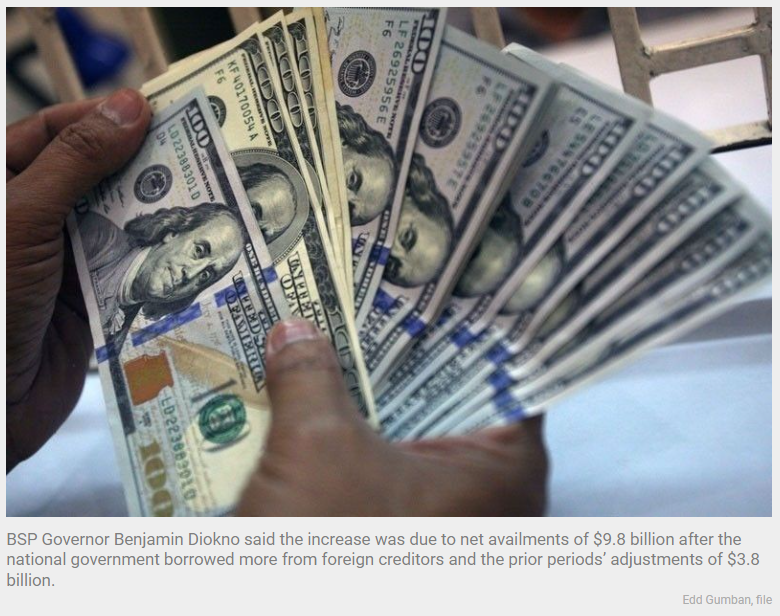Philippines external debt hits $106.4 billion
MANILA, Philippines — The foreign obligations of the Philippines went up by 8.1 percent to $106.43 billion last year as the national government borrowed more, including the emergency reserve fund from the International Monetary Fund (IMF), to finance the country’s COVID-19 response measures.
BSP Governor Benjamin Diokno said the increase was due to net availments of $9.8 billion after the national government borrowed more from foreign creditors and the prior periods’ adjustments of $3.8 billion.
Diokno said the rise was partially offset by the increase in residents’ investments in debt papers issued offshore of $3.7 billion and negative foreign exchange revaluation of $2 billion as the US dollar strengthened against other currencies such as the Japanese yen and the euro.
The country’s external debt has been steadily rising from $73.1 billion in 2017, $78.96 billion in 2018, $83.62 billion in 2019 and $98.49 billion in 2020.
Despite the increase, the BSP chief said the country’s outstanding external debt remained at prudent level, as its ratio to the gross domestic product (GDP) stood at 27 percent in 2021 from 27.2 percent in 2020.
“The ratio remains one of the lowest, as compared to other ASEAN member countries,” Diokno said.
He said the country’s gross international reserves (GIR) level stood at $108.8 billion in 2021, equivalent to 7.2 times cover of the short-term debt.
The Philippines emerged from the pandemic-induced recession with a GDP growth of 5.6 percent last year, reversing the 9.6 percent contraction in 2020 as the economy stalled due to strict COVID-19 protocols and lockdown measures.
Data showed the debt service ratio increased to 7.2 percent last year from 6.7 percent in 2020 due to higher payments. The ratio, which relates principal and interest payments to exports of goods and receipts from services and primary income, is a measure of adequacy of the country’s foreign exchange earnings to meet maturing obligations.
For the fourth quarter of 2021, the country’s external debt rose by 0.5 percent compared to the $105.9 billion in the previous quarter.
Data showed public sector external debt decreased by two percent to $63.9 billion in end-December 2021 from $65.2 billion in end-September, accounting for 60 percent of the country’s foreign debt.
The national government accounted for 86.7 percent or $55.4 billion of the total public sector debt, while government-owned and controlled corporations, government financial institutions and the central bank cornered the remaining 13.3 percent or $8.5 billion.
Meanwhile, the foreign obligations of private companies inched up by 4.4 percent to $42.5 billion in end December from $40.7 billion in end September for a share of 39.9 percent.
According to the BSP, major creditor countries include Japan with $14.6 billion followed by the US with $3.8 billion, the United Kingdom with $2.8 billion, and the Netherlands with $2.8 billion.
Borrowings from multilateral lending institutions and bilateral creditors emerged as the largest share of 37.2 percent, followed by loans in the form of bonds or notes with 34.7 percent, and obligations to foreign banks and other financial institutions with 22.3 percent.
The remaining 5.8 percent were owed to other creditors such as suppliers and exporters.
In terms of currency mix, the country’s debt stock remained largely denominated in US dollar with 55.4 percent and Japanese yen with 9.8 percent. US dollar-denominated multi-currency loans from the World Bank and Asian Development Bank accounted for 19.6 percent.
Data showed the maturity profile of the country’s external debt remained predominantly medium and long-term in nature with original maturities longer than one year with share to total at 85.8 percent, while short-term accounts with maturities of up to one year comprised the 14.2 percent balance.
“This means that foreign exchange requirements for debt payments are well spread out and, thus, manageable,” Diokno said.
The national government borrows heavily from foreign and domestic creditors to finance the country’s budget deficit as it spends more than what it actually earns.
The country’s budget shortfall swelled to a record P1.67 trillion in 2021 as the pandemic-induced recession pulled down revenue collections, while spending soared to finance COVID-19 response measures.
Source: https://www.philstar.com/business/2022/03/21/2168675/philippines-external-debt-hits-1064-billion


 Thailand
Thailand




